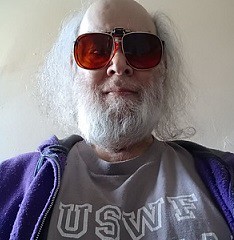Wednesday, December 16, 2020
'Sumo East And West' Review from 2003
The film itself is not now available for streaming, according to a recent conversation with its filmmakers, Ferne Pearlstein and Bob Edwards, but they do hope to get it back up soon somewhere. I've done other later analyses of the ups and downs of the World Sumo Challenge and World Sumo League in 2005 and 2006, a tribute to Manny Yarbrough who passed away five years ago this month, and am currently doing interviews about the recent revival of sumo in the U.S., all of which can be found on this site. Hopefully those involved in sumo today can learn from the positive and negative lessons of what has happened to the sport outside Japan in the past. Arigato.]
'Sumo East And West' -- Another Winning Combat Sports Film At Tribeca Film Festival
While many people around the world are aware of the existence of sumo, outside of Japan few know much
about its inner workings, history, and tradition. A new film, 'Sumo East and West,' which just debuted at the
Tribeca Film Festival in New York this past week, provides a stirring, in-depth look at this often closed world. Put together by two American filmmakers, Ferne Pearlstein and Robert Edwards, who admittedly aimed at presenting 'the perspective of outsiders,' this documentary is a film that can make you fall in love with sumo.
Much of the film centers on the struggles of American sumo wrestler Wayne Vierra, who had to cut short his pro sumo career in Japan because of injuries. Vierra returned home to Hawaii, and has also returned to sumo, but this time on the amateur circuit, outside Japan. While Pearlstein and Edwards are filmmakers and not sports journalists, their focus on Vierra and several American-born sumo legends like Akebono, Konishiki, Jesse Kuhaulua, and Manny Yarbrough, is done in the grand tradition of sports story-telling that features the human side of the competitions.
As Akebono said in the film, sumo is not merely a sport. Rather, it is a lifestyle. That is captured vividly here with behind-the-scenes shots contrasting the life and treatment of the newcomers to sumo, who are on the lowest rung of its ladder, and the stars and champions, who are treated like gods in Japan. The difficulties of Americans breaking into this world are dealt with clearly, including the controversial failure of Konishiki ever to be awarded the status of Yokozuna (Grand National Champion).
The film also explores the attitude of the official sumo establishment to women. While the rising amateur sumo ranks include women's competition, in pro sumo in Japan, women are still prohibited from even entering the dohyo, or match circle. Pearlstein related after the film's showing that when they were shooting it in Japan, she had to be careful not to enter the dohyo, lest the Japan Sumo Association revoke the access they had provided to the filmmakers.
This moving film is not a movie just for hardcore sumo fans, which is also its strength. There are plenty of
places for that kind of documentation. What is missing, especially in North America, is a good introduction to
the sport and its culture. That is accomplished here by Pearlstein and Edwards, who also do not come from the worlds of martial arts or combat sports. They thus speak to the general public, and do so successfully. They also said that time constraints in this 85-minute film prevented them from including some topics that might have interested the more dedicated sumo fans, such as technique used in the matches. Also, they said that issues like allegations of fixed matches in sumo were not broached in this film, again because this would have had them lose the access they did have from the Japan Sumo Association. In no way does the absence of the mentioning of these issues in this film detract from the tremendous contribution it makes to building support for and understanding of sumo.
The screenings at the Tribeca Film Festival were held in a movie theater in downtown Manhattan directly next to Ground Zero. If ever you needed a reminder of the need for greater international understanding, and the destructive power of unbridled cultural and international hate, ignorance, and fanaticism, that is it. Hopefully this film can contribute to greater international understanding. A central theme was the contrast of cultures, especially between the world of sumo, which is immersed in ancient traditions, and the growing Westernization of Japan's youth, as seen by the myriad shots of Japanese youth with bleached blonde hair, Western rock 'n' roll-type outfits, and quite untraditional behavior.
In the end, sumo shows that the culture of the big guys truly has an international appeal. The failure of sumo
thus far to get a major foothold in the sports world in America is touched on here. Footage of the 1998 'Night of the Giants' tournament in Atlantic City, which was also shown on ESPN2 and was part of a failed attempt toestablish pro sumo league, are included in the film. Also shown is footage of the North American Sumo Championships, in a distinctly sleazy and cheesy presentation at Hollywood Park, in direct contrast to the solemn and graceful settings for sumo in Japan.
'Sumo East and West' will soon be widely available to the general public. Edwards said to expect it to be
broadcast early next year in the U.S. on PBS, although that version will have to be cut down to fit into an hourlong timeslot. The filmmakers have also retained the video rights, so expect a video of the complete version to be available soon as well.
This touching film could contribute to the growth of sumo in America. Since it was shot in 2000, there have been some welcome developments in sumo in America. The California Sumo Association has already hosted two annual U.S. Sumo Open tournaments. The second was covered in the April 2003 edition of Grappling. The 3rd annual U.S. Sumo Open will take place Sunday, August 3, at the Manhattan Country Club in Manhattan Beach, CA, in the Los Angeles area. For more information, go to:
https://www.usasumo.com.
So, in the wake of last year's 'The Smashing Machine: The Life and Times of Mark Kerr,' the combat sports
have provided the story for yet another triumphant documentary at the Tribeca Film Festival. That shouldn't be surprising, since many of us have long felt that the drama that unfolds in the combat sports is unparalleled anyway. Now many in the filmmaking world are also discovering that, a development which can only be mutually beneficial.
I generally don't review movies, so I don't have a standard scale to rate them. Whichever scale you like, this one gets the highest rating possible. 'Sumo East and West' is a wonderful, must-see film not only for sumo and combat sports fans, but for anyone who can appreciate a great, true story. Don't miss it when it comes your way.
Comments:
Post a Comment
















